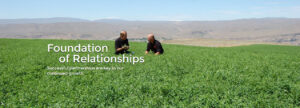Hay Quality for Horses & Livestock
In the agriculture industry, the quality of forage for horses, cows and livestock is measured by the levels of energy, fiber, and other essential nutrients they provide. Growing environment, soil conditions, and harvesting technique all impact forage quality. The physical attributes of forages (smell, color, leafiness) are not as specific indicators of quality as chemical analysis.
One factor to consider when looking at you forage options is the concentration of phosphorus (P) as different levels affect digestion and animal productivity.
Find out why you should assess levels and what percentages you’ll find in common types of forages.
What is phosphorus in forages?
Phosphorus in forages is processed during photosynthesis to convert light energy into chemical energy. This energy is absorbed by the plant for growth and development. Phosphorus is especially critical during a plant’s establishment phase because of its impact on root growth. Phosphorus levels impact the digestibility of dry matter, as a certain minimum level is essential for the transfer of carbohydrates.
Phosphorus is also a key factor in the establishment of forage legumes, such as Alfalfa, which impacts dry-matter yields in forages.
Why is phosphorus important?
Phosphorus is the key nutrient in getting a pasture stand established. Soil should be tested to determine nutrient levels (e.g., phosphorus, potassium, nitrate) prior to broadcasting.
In forages, the primary task of phosphorus is transforming protein, fat, and carbohydrates into energy. It also:
- Strengthens bones and teeth
- Delivers oxygen to the body’s systems
- Helps maintain pH in the body
- Develops connective tissues
- Produces hormones
A shortage of phosphorus in the body can be serious as it can lead to reduced appetite, weight loss, skeletal weaknesses, and decreased milk production in lactating livestock. A deficiency of phosphorus is the most economically critical of all the mineral deficiencies that can impact livestock.
What percentage of phosphorus is found in different types of forages?
The level of phosphorus in various forages is important as it relates to the ratio of calcium, alongside the presence of Vitamin D. Vitamin D3 is essential for the utilization of calcium, as deficiencies in the vitamin will change the amount of calcium available, thus offsetting the phosphorus ratio. The recommended ratios of calcium to phosphorus are as follows:

How do you maintain phosphorus levels in forages?
Phosphorus accumulates quickly in soil due to repeated fertilizer treatments. While those forages that are regularly harvested maintain proper levels, producers that over-apply liters and manures to stimulate growth run into problems.
If manure is applied to soil, it should be dragged with a harrow to distribute nutrients. If manure is not applied, soil should be tested to determine nutrient levels (e.g., phosphorus, potassium, nitrate) prior to broadcasting.
When choosing the best forage for your horse’s nutrition, you should evaluate the phosphorus levels in your forage. The levels of acid detergent or neutral detergent fibers, nitrates, and crude protein are other indications of high standards in forage products.
More Reading:
Learn more about Phosphorus in Animal Nutrition in this article from Better Crops.


